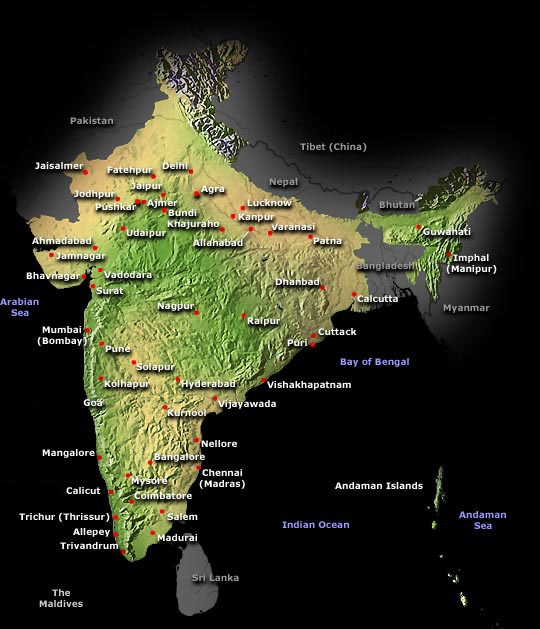July 3, 2007 - Ethiopia
In a country where some roads are so underdeveloped that they turn a 20-mile stretch into a 5-hour excursion, small propeller planes have become like buses. We hopped on one such plane this morning at 6:30AM and proceeded to fly north about 300 miles dropping passengers off and picking some up at three cities along the way. We arrived at our final destination, Aksum, at 10:45AM and were happy to finally step down to the gravelly earth. Glancing across the runway, I saw millipedes scampering in several directions; some less fortunate ones remained as half-squished corpses, having crossed paths with planes and passengers.
Thatch-roofed huts nestled into the hillside and presented quite the contrast to the four-year-old airport building that looked like someone had planted a pristine architecture model in the rocky landscape and carefully cultivated it to its present size.
As we picked up our luggage, two men outside the airport main lobby waved crazily and smiled at us. These were Kahsai and Daniel, two representatives from REST (Relief Society Tigray—Tigray being a region in the northern part of Ethiopia). As the five of us (Kahsai, Daniel, Charly, Alex, and I) drove out of the airport, it was hard not to notice evidence of UN peacekeeping forces—UN cars and uniformed foreigners could be found on the roads and in our hotel. These forces have been administering the Eritrea-Ethiopia border zone (a 20-km dead zone) since 2000 (or 1992 by the Ethiopian calendar, which is 8 years behind ours-and means that Ethiopians are getting ready to celebrate their millennium!). The last big skirmishes between Ethiopia and Eritrea were from 1998 to 2000, at which point the UN stepped in. Such fighting is certainly nothing new to the region, but it really is sad to think Eritreans and the people of Tigray share the same culture and language (something not all too common in Ethiopia, where there are over 80 ethnic groups that each have their own language and culture). The only main difference between the two regions remains political. While there is currently still a no-pass policy and you certainly don’t want to be found lingering near the border, the Eritrea/Ethiopia border conflict has lately become less of a concern than the Somalia border, as Islamist clans are becoming more unsettled. These delicate political relations remind us how carefully the new Ethiopian democracy must tread.
You may have noticed that REST stands for RELIEF Society Tigray. This name stems from the days when REST was in fact only a relief organization. Starting its work thirty years ago, REST played a critical role in the Tigrayan People’s Liberation Front (TPLF) and the fight against the Soviet-backed Derg government. In 1984, when a devastating draught hit Ethiopia, and the Derg government left Tigray behind, REST was the main source of relief and solidified a lasting trust with villagers across Tigray. Once the main effects of famine were quelled, REST realized that helping people help themselves was a more sustainable and successful model than giving handouts. As a result, they made the transition from being a relief organization to becoming a development organization.
Kahsai shared bits and pieces of REST’s story throughout the afternoon as he led us through the city of Aksum. When we arrived at the Aksum tourist bureau, a local historian joined us and told us about Aksum’s incredibly rich history that goes back to the 10th century BC when it was Queen of Sheba’s capital. Though it is now known as the “declining city,” Aksum was long a cultural center and dominated the Africa/Asia ocean trade for nearly 1000 years!
One of my favorite archaeological sites was Queen of Sheba’s Palace. Although the second storey is no longer present, there is still evidence of a throne room, a kitchen (complete with a brick oven that holds some of the earliest bricks ever discovered), and the Queen’s bathroom (with a stone bath mat and water-delivery system attached to an adjacent water collecting room).
Another less inviting archaeological site was that of the tombs of King Kaleb and his son King Gebre Meskel. As we climbed down the steps of King Kaleb’s tomb, the smell of bat guano prickled our noses and one flew straight over us as we stepped into the coffin room. Although all the treasures were looted long ago, the architecture of the chamber itself provided more than enough eye candy (not to mention the added excitement of uncovering a whole pocket of bats hanging in the darker corners of the ancient treasure vault). The walls were built of irregular shaped slabs of stone that fit together without any need for mortar, and above our heads, one gigantic stone slab covered the roof of each room. King Kaleb’s son built a tomb with far more regular rectangular stones but still avoided the use of mortar.
One of our last stops on our cultural tour was the stelae field. Stelae are huge slabs of stone that were erected in honor of very important leaders. There are three main types of stela: engraved, plan, and natural rock. While some of the stelae tower up to 33 meters and create an amazing sight, I was even more intrigued by the fact that 98% of the area’s treasures still lie undiscovered in the too-dangerous-to-navigate chambers beneath your feet.
It was quite a tour-de-force today and we were barely able to pry ourselves out of bed again after taking a quick nap before dinner.
The wedding music that is now floating across the courtyard from a nearby wedding will not have any effect on my sleep, of that I am certain!
Saturday, July 7, 2007
Subscribe to:
Post Comments (Atom)

No comments:
Post a Comment